OCZ Vertex 3 (240GB) Review
by Anand Lal Shimpi on May 6, 2011 1:50 AM ESTAnandTech Storage Bench 2011
Last year we introduced our AnandTech Storage Bench, a suite of benchmarks that took traces of real OS/application usage and played them back in a repeatable manner. I assembled the traces myself out of frustration with the majority of what we have today in terms of SSD benchmarks.
Although the AnandTech Storage Bench tests did a good job of characterizing SSD performance, they weren't stressful enough. All of the tests performed less than 10GB of reads/writes and typically involved only 4GB of writes specifically. That's not even enough exceed the spare area on most SSDs. Most canned SSD benchmarks don't even come close to writing a single gigabyte of data, but that doesn't mean that simply writing 4GB is acceptable.
Originally I kept the benchmarks short enough that they wouldn't be a burden to run (~30 minutes) but long enough that they were representative of what a power user might do with their system.
Not too long ago I tweeted that I had created what I referred to as the Mother of All SSD Benchmarks (MOASB). Rather than only writing 4GB of data to the drive, this benchmark writes 106.32GB. It's the load you'd put on a drive after nearly two weeks of constant usage. And it takes a *long* time to run.
Here's a high level overview:
1) The MOASB, officially called AnandTech Storage Bench 2011 - Heavy Workload, mainly focuses on the times when your I/O activity is the highest. There is a lot of downloading and application installing that happens during the course of this test. My thinking was that it's during application installs, file copies, downloading and multitasking with all of this that you can really notice performance differences between drives.
2) I tried to cover as many bases as possible with the software I incorporated into this test. There's a lot of photo editing in Photoshop, HTML editing in Dreamweaver, web browsing, game playing/level loading (Starcraft II & WoW are both a part of the test) as well as general use stuff (application installing, virus scanning). I included a large amount of email downloading, document creation and editing as well. To top it all off I even use Visual Studio 2008 to build Chromium during the test.
Digging a little deeper, the test has 2,168,893 read operations and 1,783,447 write operations. The IO breakdown is as follows:
| AnandTech Storage Bench 2011 - Heavy Workload IO Breakdown | ||||
| IO Size | % of Total | |||
| 4KB | 28% | |||
| 16KB | 10% | |||
| 32KB | 10% | |||
| 64KB | 4% | |||
Only 42% of all operations are sequential, the rest range from pseudo to fully random (with most falling in the pseudo-random category). Average queue depth is 4.625 IOs, with 59% of operations taking place in an IO queue of 1.
Many of you have asked for a better way to really characterize performance. Simply looking at IOPS doesn't really say much. As a result I'm going to be presenting Storage Bench 2011 data in a slightly different way. We'll have performance represented as Average MB/s, with higher numbers being better. At the same time I'll be reporting how long the SSD was busy while running this test. These disk busy graphs will show you exactly how much time was shaved off by using a faster drive vs. a slower one during the course of this test. Finally, I will also break out performance into reads, writes and combined. The reason I do this is to help balance out the fact that this test is unusually write intensive, which can often hide the benefits of a drive with good read performance.
There's also a new light workload for 2011. This is a far more reasonable, typical every day use case benchmark. Lots of web browsing, photo editing (but with a greater focus on photo consumption), video playback as well as some application installs and gaming. This test isn't nearly as write intensive as the MOASB but it's still multiple times more write intensive than what we were running last year.
As always I don't believe that these two benchmarks alone are enough to characterize the performance of a drive, but hopefully along with the rest of our tests they will help provide a better idea.
The testbed for Storage Bench 2011 has changed as well. We're now using a Sandy Bridge platform with full 6Gbps support for these tests. All of the older tests are still run on our X58 platform.
AnandTech Storage Bench 2011 - Heavy Workload
We'll start out by looking at average data rate throughout our new heavy workload test:

The breakdown of reads vs. writes tells us more of what's going on:
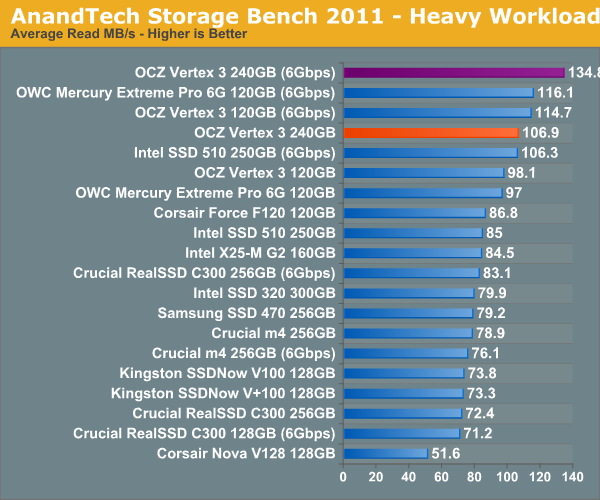
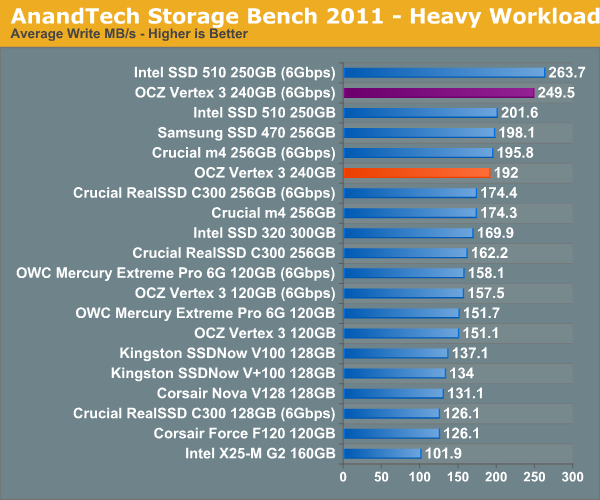
The next three charts just represent the same data, but in a different manner. Instead of looking at average data rate, we're looking at how long the disk was busy for during this entire test. Note that disk busy time excludes any and all idles, this is just how long the SSD was busy doing something:
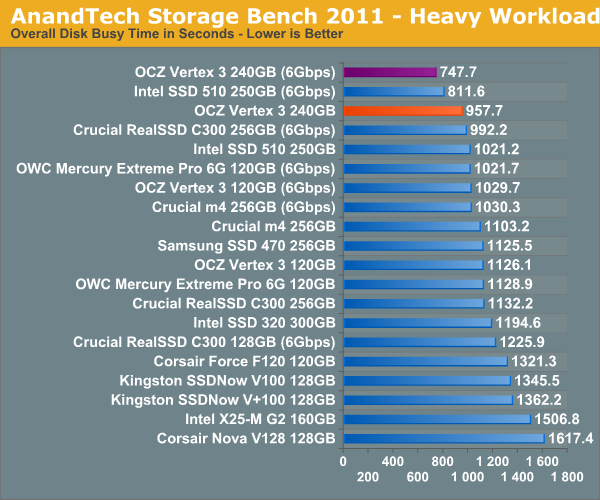
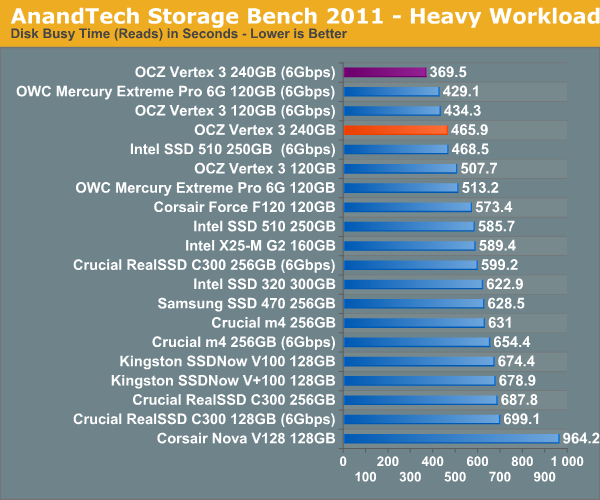
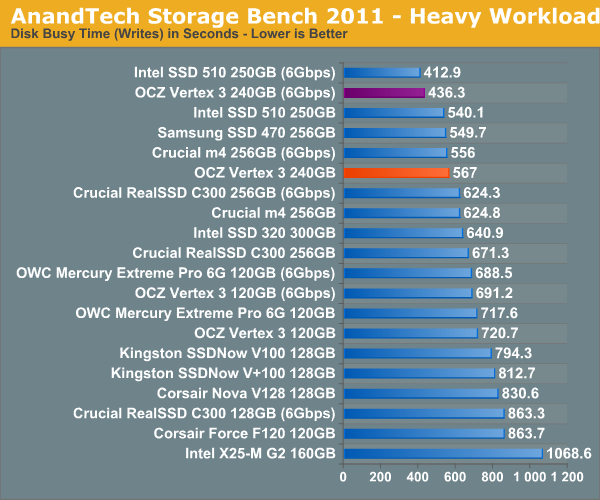










90 Comments
View All Comments
spudit99 - Friday, May 6, 2011 - link
Because these drives are so new and right on the cutting edge, this is probably not going to happen. The enthusiast community is going to do be doing this job for them, letting them both sell drives and fix issues along the way. I'm still mucking around with a year old CS300 that took months to get running as desired....Anand went through the same debacle.if you are looking for a super stable SSD with a wide compatiblity range, the OCZ Vertex 3 probably is not the best choice. I would suggest either Samsung or Intel SSD's if stability is key.
sor - Friday, May 6, 2011 - link
Unfortunately there seems to be some sort of incompatibility between Linux and the Vertex 3. Specifically newer kernels, such as most recent versions of ubuntu. Symptoms include the disk not being found on boot about 80% of the time.From the logs and reports, it looks like the disk doesn't return from the ATA 'identify' command the way linux expects it to. It's a real bummer for me since Linux is more than just a hobby, at this point I've got a 240G Vertex 3 that I can't return for anything but a replacement. Wish I would have just gone with a C300/M4, or 520.
http://www.ocztechnologyforum.com/forum/showthread...
https://bugs.launchpad.net/ubuntu/+source/linux/+b...
sor - Friday, May 6, 2011 - link
I should add that we use hundreds of SSDs at work. We deploy maybe 8-10 a week. We've been eagerly awaiting the new Sandforce controllers to come out in order to try to use them in our servers, but since they don't play nice with Linux it's out of the question. Maybe another brand would work, but my impression was that the firmwares are mostly the same and come from Sandforce.DanaG - Friday, May 6, 2011 - link
If the Vertex 3 is anywhere near as buggy as the Vertex 2, I don't want one.It seems the drive can't handle ATA Security, even though it claims support for it. The drive fails to respond if given non-data (such as "unlock") commands after resume from suspend!
http://www.ocztechnologyforum.com/forum/showthread...
jcompagner - Saturday, May 7, 2011 - link
ah, then this is what i had with an older driver of intelBSOD always when resuming
The latest driver of intel i don't have that problem anymore but i guess that now doesn't send that command or something
But yes i already told OCZ at there forum that they really should look into this, that it is not a real driver issue (yes the driver can fix it by not sending those commands) but it is really an issue that the Vertex 2 or 3 doesn't really work well with all the sata commands, i think many problems reported by many peoples are all coming down to that.
OCZ/Sandforge should really really be looking into that!
DanaG - Monday, May 9, 2011 - link
For me, it's not the driver doing it -- the same happens in both Windows and Linux. It's my laptop's firmware that's sending "non-data commands".How can you claim to "support" ATA Security if the drive becomes unresponsive when told to unlock? If you suspend with drive locked, you can be nearly 100% certain you'll want to unlock the drive at resume.
For some people, it doesn't even take lock/unlock to make the drive crap out -- perhaps the BIOS calls an IDENTIFY command, or such.
Anand, can you please try to get OCZ and/or Sandforce to do something about this buggy firmware? My old Indilinx drive handled suspend/resume (while locked) perfectly fine!
Check out that forum post for info on how to reproduce the issue.
danjw - Friday, May 6, 2011 - link
I am considering switching to an SSD on my desktop. Currently, I have a regular defrag scheduled via windows scheduler. Should I get rid of this for an SSD?evilspoons - Friday, May 6, 2011 - link
Yes, definitely. The Intel SSD toolbox actually does this automatically if it detects a scheduled defrag.Spacecomber - Friday, May 6, 2011 - link
I know that you've got your hands full with keeping up with reviewing the individual SSD models that are being released, Anand, but I think it would be helpful if you or another writer could put together a guide or overview of this hardware segment for someone thinking to take the plunge into a SSD for their system.Things that I would be interested in are bang for your buck comparisons, which types of drives would be the best match for particular usage scenarios, and which drives are likely to be the easiest to adapt to and most trouble free to use.
As I think you suggested in an earlier comment (re: vertex 2 vs vertex 3), a lot of the differences between these drives covered in these detailed reviews are not necessarily differences that can be readily detected in actual use, and the big difference is between a normal HDD and a SDD. Yet, I don't think that this means we are at a stage where you simply look for the least expensive SSD that has the capacity you want (which seems to be pretty close to the case when it comes to HDDs, these days).
I've read these SDD reviews with varying degrees of scrutiny, since I'm not necessarily ready to buy one right now. If I had to simplify what I've taken away these reviews, so far, into a rule of thumb, it would be to buy the largest capacity Intel drive that I could afford. Of course, I may be way off base in reaching that conclusion, which is why I would be interested in a guide.
spudit99 - Friday, May 6, 2011 - link
Company I work for has deployed several SSD's in laptops especially. Samsung and Intel drives have been trouble free, although not always at the very top of speed list.Best advice I can give is find a good buy and try one out. My personal experience is extremely positive, even with the 2+ year old SSD drive in my laptop. Yes, the cost is high, but IMO the performance gain is hard to beat.
They are fast, quiet, and as long as you aren't trying to be the first to have the latest product, very reliable. The only SSD trouble I've had was with a personal purchase (CS300), which took a return and several firmware updates to fix. Reading about this stuff is great, but unless you want to pave the way, I would be at least somewhat conservative.